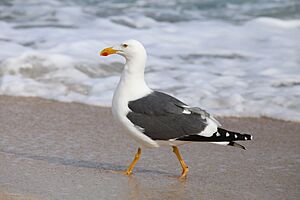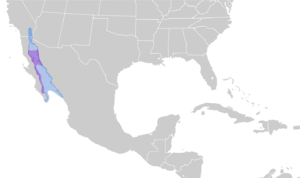Yellow-footed gull facts for kids
Quick facts for kids Yellow-footed gull |
|
|---|---|
 |
|
| Conservation status | |
| Scientific classification | |
| Genus: |
Larus
|
| Species: |
livens
|
 |
|
| Distribution Non-Breeding Year-round | |
The yellow-footed gull (Larus livens) is a large gull. It's a special bird found only in the Gulf of California in Mexico. For a long time, people thought it was just a type of western gull. But now we know it's its own unique species!
Contents
What Does the Yellow-Footed Gull Look Like?
Adult yellow-footed gulls look a lot like western gulls. They have a white head and dark, slate-colored backs and wings. Their strong bill is yellow and quite thick.
Their legs are also yellow. However, young gulls in their first winter have pink legs. They will get their full adult feathers and colors when they are about three years old.
This gull is one of the biggest gulls in the world! It's about the same size as the slaty-backed gull. It is even a little bigger than the western gull.
These gulls can be from 53 to 72 centimeters (21 to 28 inches) long. Their wings can spread out from 140 to 160 centimeters (55 to 63 inches) wide. They usually weigh between 930 and 1500 grams (2 to 3.3 pounds).
Where Do Yellow-Footed Gulls Live?
Yellow-footed gulls are native to the Gulf of California in Mexico. This means they naturally live there and nowhere else. Most of these gulls do not migrate, so they stay in the Gulf of California all year.
However, more and more yellow-footed gulls are starting to travel. Some fly north to California's Salton Sea. Others go south to Sonora when they are not breeding.
Their favorite places to nest are sandy or rocky coasts and islands. These spots often have very few plants. They build their nests in April. They might nest alone or in large groups called colonies.
How Do Yellow-Footed Gulls Behave?
Yellow-footed gulls are both scavengers and foragers. This means they eat many different things. They look for small fish and tiny ocean creatures called invertebrates. They also eat dead marine animals and leftover bits from fishing.
Sometimes, they hunt for food. They will eat the chicks and eggs of other seabirds, including pelican eggs. You might see them looking for food around trash dumps and docks. But they usually do not fly far away from the coast.
Nesting and Raising Young
Yellow-footed gulls build their nests right on the beach. They choose a spot a few meters above where the highest tides reach. The nest is a simple scrape in the sand. They might add a little bit of seaweed or dry plants to line it.
A pair of gulls will protect a small area around their nest. This area stretches from the nest to the sea. The female usually lays three eggs. The eggs are olive or buff-colored with dark spots.
Both parents likely help to incubate the eggs. This means they take turns sitting on the eggs to keep them warm. The young gulls are ready to leave the nest when they are about seven weeks old. At this age, they are fully fledged, meaning their feathers are grown enough for them to fly.
Is the Yellow-Footed Gull in Danger?
Scientists estimate there are about 60,000 yellow-footed gulls. This number seems to be staying steady. Because of this, the IUCN (International Union for Conservation of Nature) says the species is of "least concern." This means they are not currently at risk of disappearing.


